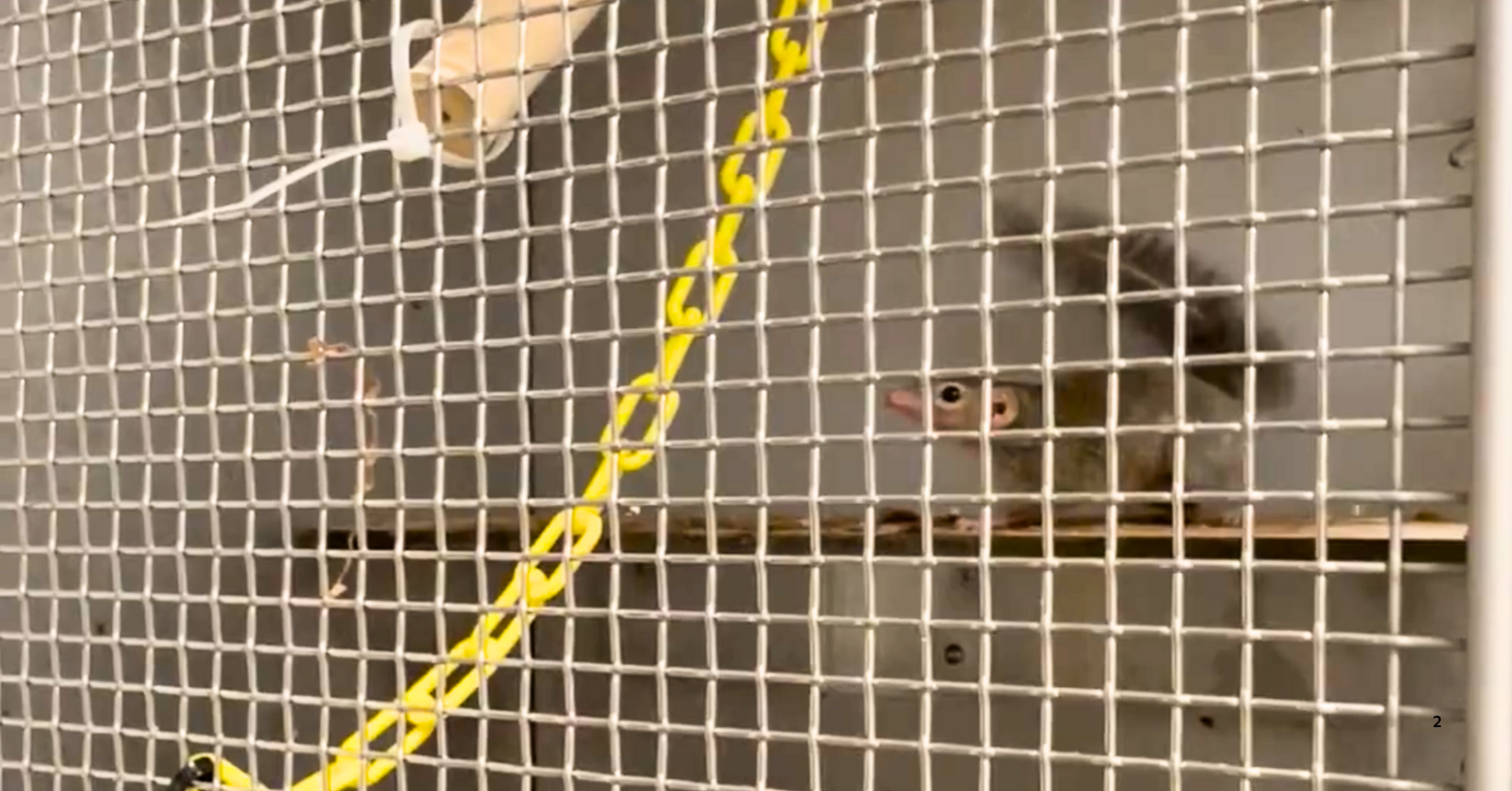
Dealing in Suffering: The Torture & Trade of Primates’ Kin
Animal Partisan has uncovered even more horrifying truths about what animal researchers are doing to – and not doing for – the nonhuman animals they harm for profit.
Public records obtained by Animal Partisan reveal that, in addition to smoking ferrets and depriving them of water, University of Alabama-Birmingham (“UAB”) researchers are destroying the eyes of tree shrews and leaving them to suffer – and literally go mad – in the filthiest of cages.
In January 2024, the USDA recorded a tree shrew “exhibiting repetitive flipping in circles (stereotypic behavior)” in their metal cage.
Stereotypic behaviors like this are wholly abnormal for animals yet disturbingly common in animals confined in laboratories – including, undoubtedly, at UAB, where the USDA documented that staff had neither noted nor otherwise addressed it. These behaviors result from severe and chronic stress and starkly indicate poor welfare.
They also signify bad science.
Stereotypic behaviors – like repetitive flipping in circles – suggest that an animal is “expressing abnormal physiology”, which scientists concede may well jeopardize the validity, reliability, and replicability of any research using that animal.
Yet, animal researchers continue to house animals in conditions that cause stereotypic behaviors and use them in experiments at the same time.
At UAB, tree shrews – just like, if not including, the poor individual observed by the USDA – are brutalized for various forms of eye “research” claimed to study human eye problems including myopia, dry eye disease, diabetic retinopathy, and other “eye diseases” like glaucoma, which provides a great case study for the rest.
UAB researchers continue to receive federal monies to damage shrews’ eyes by forcing up intraocular pressure without benefit to the many humans suffering from glaucoma worldwide; in fact, despite untold years’ of “substantial” nonhuman animal “research in the field of glaucoma”, researchers remain stuck on step one: they’re “still trying to develop a fundamental understanding of the mechanisms that cause this disease” in humans.
Tree shrews are UAB’s current “model” of choice even though UAB itself laments that both primate and rodent “models” have “significant limitations or barriers to their use”. The next “logical” step for an industry that exists only because of its ability to self-perpetuate? Spending huge amounts of time and money exploiting close relatives of primates who look like rodents, of course.
In 2023, UAB reported exploiting 268 tree shrews, or one-third of all tree shrews reported by U.S. laboratories. Yet, UAB is not satisfied by its own exploitation of these wild animals – “the closest phylogenetic relative of primates that can be kept in a laboratory setting”. It also seeks to make money from expanding these animals’ exploitation nationally.
Through its Tree Shrew Core (TSC), UAB runs a breeding colony of tree shrews and sells juveniles, young adults, and “retired breeders (1 – 6 years old)”. In industry “lingo”, UAB deals in tree shrews, with the goal – in its own words – of “expand[ing] the use of this near-to-primate animal at UAB and nationally.”
And, like any good dealer, it wants to get others hooked. UAB sells shrews for “$700 each” to “established investigators” (which are supported by multiple federal grants from the NIH’s National Eye Institute), while offering a perverse special-of-sorts to “encourage new investigators . . . to begin using tree shrews”: “up to 10 animals can be made available at a cost of $50 each.”
At other institutions – the institutions that UAB, no doubt, has already hooked or seeks to hook on shrews – these wild beings are forced to endure every kind of horror: infectious diseases (such as hepatitis and herpes), bacterial infections, immune-related diseases, all kinds of cancer and other tumors, metabolic diseases (like diabetes, fatty liver, and blood vascular disease), mental diseases (like depression), drug addiction, nerve-related diseases, Alzheimer’s, and, yes, vomiting.
At the same time that UAB breeds, tortures, and sells-for-torture these sentient beings, UAB can’t even be bothered to provide them with the most basic of care.
During the same inspection previously referenced, the USDA observed 1) a tree shrew suffering from “patchy hair loss along his entire tail”, for which he had not received any veterinary care, 2) tree shrews incarcerated within enclosures “not structurally sound to protect the animals from injury”, and 3) tree shrews forced to exist in filthy enclosures with feces “both fresh and old [] built up on the perches, shelves, and the floor[s]”, upon which it was “mixed with food pellets”.

These conditions at UAB are not aberrations. Case and point: months earlier, in May 2023, the USDA documented that UAB’s tree shrews’ feet were “contaminated by feces” and that UAB’s tree shrew enclosures “are dirty and in need of cleaning”, with feces “both fresh and up to four weeks old” having “built up on the perches, shelves, “the back wall[s]”, and “the floor[s]” (with some of the feces on the floor “growing fuzzy white mold”).
And, these horrors are not unique to UAB – they are ubiquitous in animal research, an industry that deals in suffering, not science, and must be stopped.
Please help us spread the word, creating awareness and building momentum in the movement to free every single primate, every single rodent, every single primate-and-rodent-like mammal, and every single other sentient being from every single laboratory.